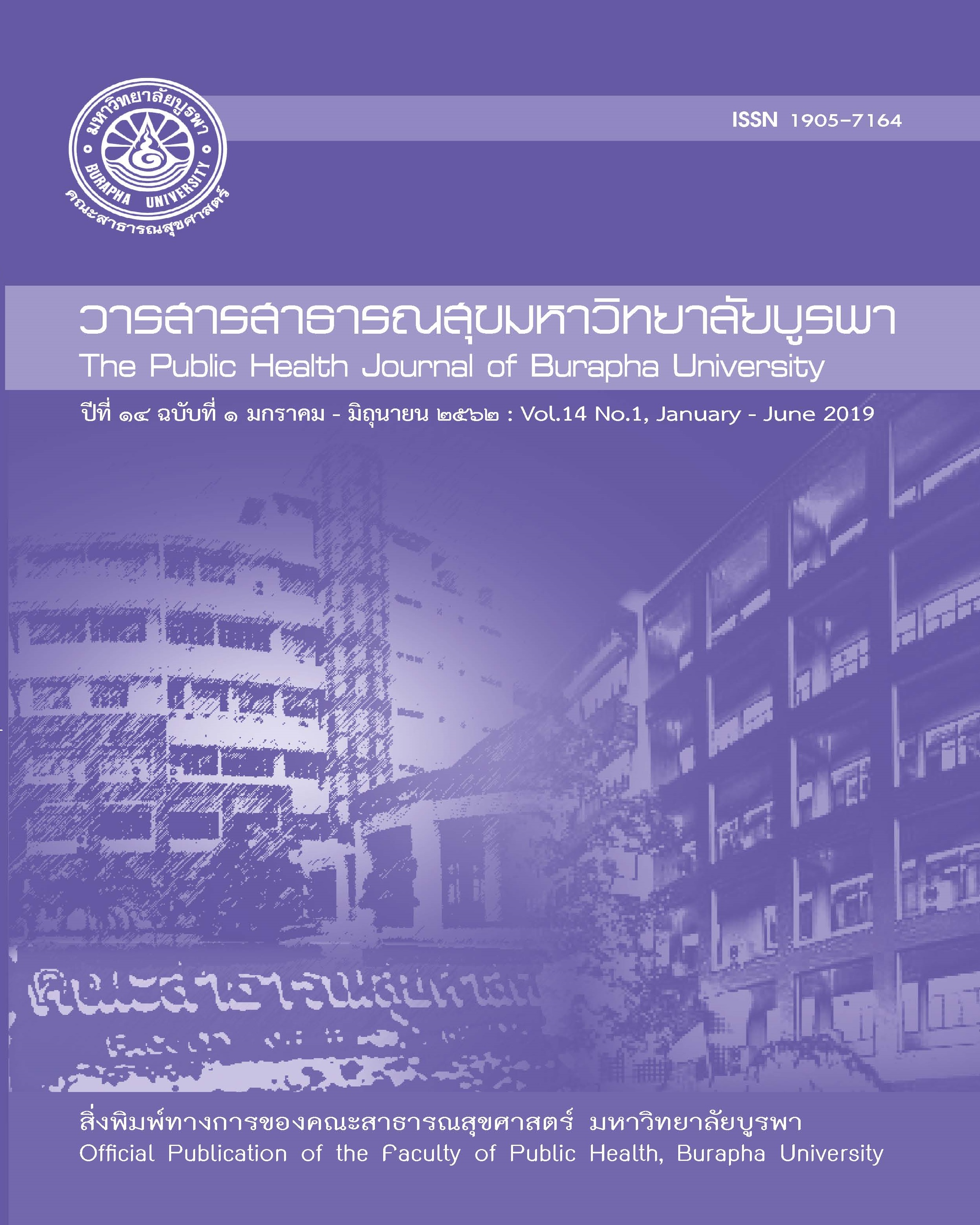การทบทวนสถานการณ์การจัดบริการภายใต้โครงการงบจ่ายตามตัวชี้วัดเกณฑ์คุณภาพและผลงานบริการในหน่วยบริการปฐมภูมิ
Main Article Content
บทคัดย่อ
Reviewing the situation of service provision under the Quality and Outcome Framework (QOF)
in primary care units
โครงการงบจ่ายตามตัวชี้วัดเกณฑ์คุณภาพและผลงานบริการในหน่วยงานปฐมภูมิ เริ่มดำเนินการโดยสำนักงานหลักประกันสุขภาพแห่งชาติ (สปสช.) ในปีงบประมาณ 2557 มีจุดมุ่งหมายที่จะใช้กลไกด้านการเงินกระตุ้นหรือจูงใจให้สถานพยาบาลพัฒนาตนเองจนสามารถให้บริการปฐมภูมิที่มีคุณภาพและได้ผลลัพธ์ทางสุขภาพตามตัวชี้วัดที่กำหนด การศึกษานี้มีวัตถุประสงค์เพื่อทบทวนสถานการณ์ที่เกี่ยวข้องกับโครงการ QOF ในหน่วยบริการปฐมภูมิ โดยใช้วิธีการศึกษาเชิงคุณภาพ เก็บข้อมูลด้วยการทบทวนเอกสาร การสัมภาษณ์เชิงลึก และการสนทนากลุ่ม ซึ่งกลุ่มตัวอย่างประกอบด้วยผู้มีส่วนได้ส่วนเสีย ได้แก่ ผู้กำหนดนโยบาย ผู้บริหาร นักวิชาการ ผู้ปฏิบัติงานระดับพื้นที่ ได้แก่ สำนักงานสาธารณสุขจังหวัด (สสจ.) สำนักงานสาธารณสุขอำเภอ (สสอ.) โรงพยาบาล โรงพยาบาลส่งเสริมสุขภาพตำบล (รพ.สต.) รวมถึงหน่วยงานไม่แสวงกำไร ผลการศึกษาพบว่า จากการดำเนินโครงการ QOF ในระยะเวลา 2 ปีที่ผ่านมายังไม่มีความชัดเจนในการบรรลุวัตถุประสงค์ของโครงการ คือ การเพิ่มคุณภาพบริการปฐมภูมิ อย่างไรก็ตาม โครงการ QOF ส่งผลให้ความร่วมมือในการทำงานของเครือข่ายบริการดีขึ้น หน่วยบริการได้รับเงินสนับสนุนเพิ่มขึ้นซึ่งช่วยชดเชยความขาดแคลนของงบประมาณพื้นฐาน และผู้ปฏิบัติงานสามารถดำเนินงานตามตัวชี้วัดคุณภาพที่กำหนดไว้ได้ แต่ยังมีปัญหาอุปสรรคในการดำเนินโครงการช่วงเริ่มต้น บทเรียนที่ได้จากโครงการ QOF นี้จะเป็นประโยชน์สำหรับผู้กำหนดนโยบายและผู้ปฏิบัติงานในการปรับปรุงการดำเนินโครงการในอนาคต อีกทั้งยังชี้ให้เห็นว่า ตัวชี้วัดคุณภาพเป็นหนึ่งในเครื่องมือสำคัญที่สามารถนำมาใช้ในการพัฒนาคุณภาพงานบริการปฐมภูมิได้
In the fiscal year 2014, the National Health Security Office (NHSO) initiated the Quality and Outcomes Framework (QOF) for the Thai primary care. The purpose was to provide financial incentives to health facilities for improving the quality of primary care services by using quality indicators. Currently, no monitoring and evaluation of the program and quality indicators were conducted in systematic manner. This study aims to review current situation of the QOF program implementation, obstacles and factors affecting the implementation of the program in terms of management and the development of indicators. This qualitative study used different methods including literature review, in-depth interviews and focus group discussions. The stakeholders involved in this study were policy makers, healthcare professionals cover central and regional organizations. The study found that the QOF program implementation had some limitations including policy alignment between the Ministry of Public Health (MOPH) and the NHSO, the development of quality indicators, and the reporting systems and reliable databases. The MOPH and the NHSO should jointly manage the project at the policy level and implement the policy in the same direction, indicators should be developed from evidence based, transparent process and involvement of all relevant stakeholders and improving the information technology system of the MOPH so that reliable data can be obtained and used. Finally, the learned lessons on the current QOF will be useful for policymakers and health practitioners in improving the implementation of this initiative.
Article Details
References
2. Campbell SM, Reeves D, Kontopantelis E, Sibbald B, Roland M. Effects of pay for performance on the quality of primary care in England. The New England journal of medicine. 2009 Jul 23;361(4):368-78.
3. Evans DB, Etienne C. Health systems financing and the path to universal coverage. Bulletin of the World Health Organization. 2010 Jun;88(6):402.
4. Tompkins CP, Higgins AR, Ritter GA. Measuring outcomes and efficiency in medicare value-based purchasing. Health Aff (Millwood). 2009 Mar-Apr;28(2):251-61.
5. Analysis and assessment of manpower unit, Siriraj Hospital. Full Time Equivalent (FTE). 2013.
6. National Health Security Office. Guideline for evaluation of indicators based on quality criteria and service performance for fiscal year 2014. 2014.
7. Britton JR. Healthcare Reimbursement and Quality Improvement: Integration Using the Electronic Medical Record Comment on "Fee-for-Service Payment - an Evil Practice That Must Be Stamped Out?". Int J Health Policy Manag. 2015;4(8):549-51.
8. Peabody JW, Shimkhada R, Quimbo S, Solon O, Javier X, McCulloch C. The impact of performance incentives on child health outcomes: results from a cluster randomized controlled trial in the Philippines. Health Policy Plan. 2014 Aug;29(5):615-21.
9. Latham LP, Marshall EG. Performance-based financial incentives for diabetes care: an effective strategy? Can J Diabetes. 2015 Feb;39(1):83-7.
10. Tan EC, Pwu RF, Chen DR, Yang MC. Is a diabetes pay-for-performance program cost-effective under the National Health Insurance in Taiwan? Qual Life Res. 2014 Mar;23(2):687-96.
11. Chang RE, Lin SP, Aron DC. A pay-for-performance program in Taiwan improved care for some diabetes patients, but doctors may have excluded sicker ones. Health Aff (Millwood). 2012 Jan;31(1):93-102.
12. Practice Incentives Program [Internet]. Australian Goverment. 2015 [cited September 2015]. Available from: https://www.humanservices.gov.au/health-professionals/services/practice-incentives-programme/.
13. Tangcharoensathien V LS, Patcharanarumol W, et al. Achieving universal health coverage goals in Thailand: the vital role of strategic purchasing. Health Policy Plan. 2015 Nov;30(9):1152-61.
14. Number of hospitals separate by type [Internet]. Strategy and Planning Division, Office of Permanent Secretary, Ministry of Public Health. 2014. [cited January 2018]. Available from: https://203.157.10.8/hcode_2014/query_02.php?p=3.
15. Chantawanit S. Qualitative Research Methodology. 18th edition. Bangkok: Publisher of Chulalongkorn University; 2010.
16. National Health Security Office. Guidelines on the implementation of the Quality and Outcome Framework (QOF), fiscal year 2014. Bangkok: 2014.
17. National Health Security Office. QOF 2019 Indicators Guide. Bangkok 2015.
18. Director Bureau of Policy and Strategy , Office of Permanent Secretary, Ministry of Public Health. Manual of data storage and delivery according to standard health information structure, Ministry of Public Health, Version 2.0. (1 October 2014) fiscal year 2015. 2014.
19. Summary of service units registered in the Universal Health Coverage System, fiscal year 2014. [Internet]. 2014. [cited March 2018] Available from: https://www.nhso.go.th/frontend/page-contentdetail.aspx?CatID=MTA5NQ==.
20. Campbell SM KE, Hannon K, et al. Framework and indicator testing protocol for developing and piloting quality indicators for the UK quality and outcomes framework. BMC Fam Pract. 2011;12(85).
21. Khampang R, Butchon R, et al. Developing health care quality indicators and improving the QOF program for the Thai Universal Health Coverage – Part 2. Health Intervention and Technology Asessment Program. Nonthaburi, 2016.
22. Djalali S FA, Tandjung R, et al. Swiss quality and outcomes framework: quality indicators for diabetes management in Swiss primary care based on electronic medical records. Gerontology. 2014;60(3):263-73.
23. Lee JY LS, Jo MW. Lessons from healthcare providers’ attitudes toward pay-for-performance: what should purchasers consider in designing and implementing a successful program? . J Prev Med Public Health. 2012.;45(3):137–47.
24. Eijkenaar F. Key issues in the design of pay for performance programs. Eur J Health Econ. 2013 Feb;14(1):117-31.
